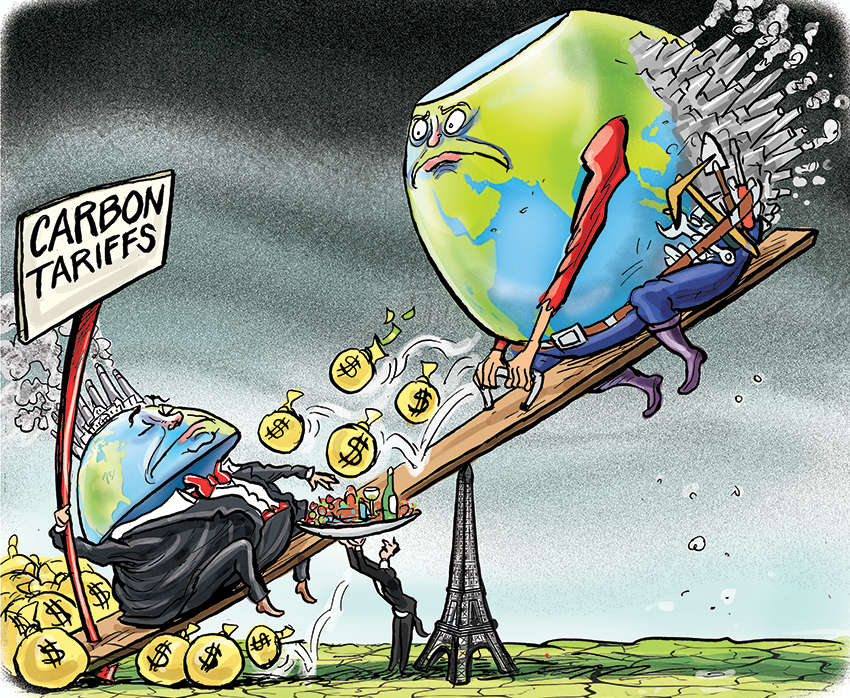To tackle climate change, rich nations are promising to end fossil fuel use in 29 years. As this becomes excruciatingly costly, the G7 is now thinking about making the world’s poor pay for it. That’ll go badly.
The rich world has seen an incredible development on the back of enormous increases in mostly fossil fuel energy. A couple of hundred years ago, most available power came from backbreaking human work. Even by the end of the 1800s, human labour made up 94% of all industrial work in the US. Today, it constitutes just 8%. If we think of the energy we use in terms of “servants”, each with the same work power as a human being, every person in the rich world today has access to 150 servants who clean, cook, drive, heat and do almost everything else for them.
Despite green protestations, rich people still get 79% of their energy from fossil fuels. Ending that will be hard, socially destabilising and surprisingly ineffective. To see how difficult, take the UN’s recent pronouncement that the Paris Agreement’s promises really mean reducing world emissions 7.6% every year this decade. The UN cheerfully notes this was almost achieved in 2020 with the global Covid shutdowns.
But this year, we need twice the reduction, equal to two shutdowns. And three in 2022, ending with the equivalent of 11 global shutdowns every year from 2030. Economic models show this’ll cost tens of trillions of dollars annually.
It’ll also destabilise rich countries. They’ve seen their per-person growth rates decline – in Europe, it’s now edging towards zero. As climate policies reduce growth further, this’ll threaten long-term social coherence as people realise their children won’t be better off and pensions wither. Moreover, the cuts will matter little for the climate. Even if all OECD nations cut their entire CO₂ emissions today, the standard climate UN model shows it’ll reduce warming by 2100 just 0.4°C.
The reason? Six billion not-rich people, many of them in India, also want access to plentiful and cheap energy, lifting them out of hunger, sickness and poverty. They’re more concerned about economic growth that’ll create welfare and resilience against disease and even climate change.
Unfortunately, climate policies harm the developing world. The current Paris Agreement will force more people into poverty by 2030 than otherwise would’ve happened. If we aim for 2°C or 1.5°C, a recent peer-reviewed study shows it’ll mean 80 million more poor and 180 million more starving by mid-century.
Now, rich countries want the world’s poor to pay the costs through carbon tariffs. The UK is pushing such tariffs as a key priority of its G7 presidency, and the proposal is falling on sympathetic ears in the US, Europe and Canada. As the US and Europe drive up energy costs, more businesses will escape to less-burdened areas like China, India and Africa. Slapping a border tariff on imports according to their underlying emissions reduces that move.
But such tariffs also make it harder for the developing world to compete, because most rich countries use carbon more sparingly. Globally, these tariffs are inefficient and make climate policies even costlier. But crucially, they act as back-door protectionism for rich countries.
For the rich world to cut 20% of its emissions, a standard model shows it’ll cost them $310 billion a year. Using carbon tariffs, the rich world can instead end up $400 billion better off, making $90 billion by forcing businesses to move back to the rich world. Instead, they impose more than half a trillion in extra costs onto the world’s poor. As one highly quoted study concludes, “The main effect of carbon tariffs is to shift the economic burden of developed-world climate policies to the developing world.”
The EU and others believe that higher tariff threats will force countries like India and China to adopt their own costly climate policies. This could be a disastrous misjudgment.
If the US were to implement a national $40 tax per ton of carbon, one recent study shows this would cost $73 billion yearly in lost growth. If the US also decided to force Chinese exports to pay tariffs equivalent to this carbon tax, it would confer a loss on China of $24 billion. But this wouldn’t help push China to implement its own $40 carbon tax domestically, because that would cost the Chinese an eye-watering $210 billion a year.
Instead, it’s likely that forcing developing countries to choose between losing billions and losing even more billions will lead to profound resentment with a rich world that claims to implement climate policies to help, but really shifts the costs onto the world’s poor. It could lead to a tariff war and the developing world shaping their separate free trading regime.
The effective way to address the real problem of climate change is to dramatically ramp up investment into green energy research and development. If the price of green energy could be innovated below fossil fuels over the next decade, everyone would happily switch.
India and its partners need to force sense back into climate policy and insist on smart green innovation. It should warn a smug West that depriving the world’s poor of the twin drivers of development, abundant energy and free trade is unacceptable.
Disclaimer
Views expressed above are the author’s own.
END OF ARTICLE






More Stories
Beyond prices: Weak demand may prove to be a bigger and stickier problem than inflation
Ask tough questions, learn: Why did the severity of India’s second wave take modellers by surprise?
Cyclone Tauktae tears up Gujarat coast; 13 dead, 16,000 houses damaged